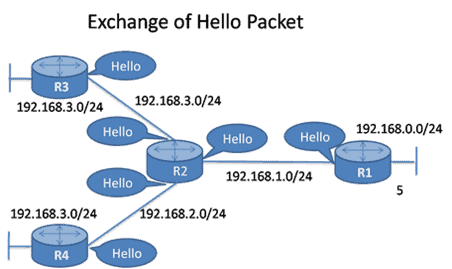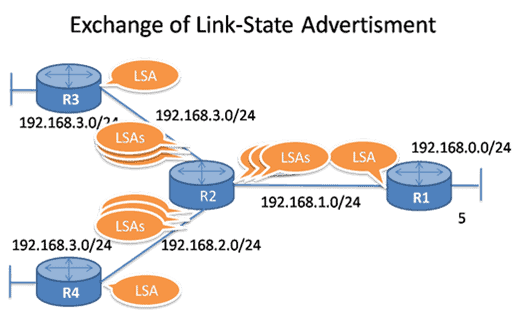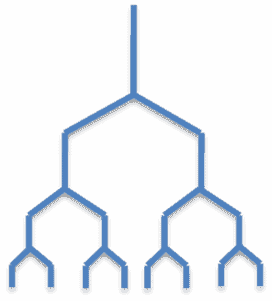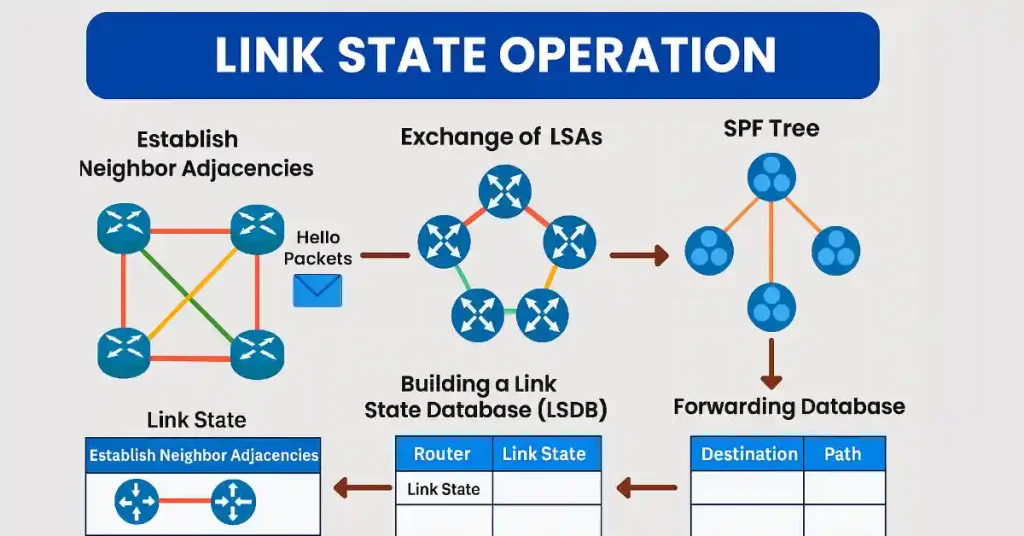Link state routing protocols, such as OSPF and IS-IS, are fundamental in modern networks due to their efficiency and scalability. For CCNA and CCNP students, mastering link-state operations is crucial for exams and real-world troubleshooting. This article dives into how these protocols work, focusing on OSPF as the primary example.
Unlike distance-vector protocols, link-state protocols minimize broadcast traffic by avoiding periodic full routing table updates. Instead, they use multicast for targeted updates and only send changes when topology shifts occur.
During initial synchronization, routers exchange Link-State Advertisements (LSAs) to build a complete topology view, not full routing tables. Post-initialization, updates are multicast only on changes (event-triggered), containing just the modified LSAs. This flooding happens immediately across the network, with parallel computations on each router, leading to rapid convergence.
Note: Hello packets are sent periodically (e.g., every 10s in OSPF) to maintain adjacencies, but they don’t carry routing data.
Event-triggered updates enhance convergence by instantly propagating changes, such as a link failure or a new connection. For instance, in OSPF, a router detects a down link via Hello timeouts (default 40s dead interval) and floods an updated LSA, allowing the network to reconverge in seconds rather than minutes.
Link-state protocols inherently support Variable Length Subnet Masking (VLSM) and Classless Inter-Domain Routing (CIDR). LSAs include subnet masks, enabling precise routing to subnets. For CCNA students: In OSPF, this means you can advertise /24 and /28 subnets without summarization issues, unlike classful protocols like RIP v1.
All link-state protocols maintain three key databases:
| Database | Description |
|---|---|
| Adjacency Database (Neighbor Table) | Lists adjacent routers and their states. |
| Link-State Database (LSDB or Topology Table) | Stores all LSAs representing the network topology. |
| Forwarding Database (Routing Table) | Contains best paths derived from the SPF algorithm for packet forwarding. |
To converge, OSPF routers follow these steps:
Establish Neighbor Adjacencies
OSPF routers form adjacencies by exchanging Hello packets on enabled interfaces (multicast to 224.0.0.5). These packets include router ID, area ID, authentication, and link states. Adjacencies require matching parameters (e.g., MTU, timers). The adjacency database is built from successful Hellos. Troubleshooting tip: Use show ip ospf neighbor to verify states like FULL.
Common adjacency issues for CCNP students include mismatched area types (e.g., stub vs. standard), authentication failures, or ACLs blocking multicast traffic. In multi-access networks like Ethernet, a Designated Router (DR) and Backup DR (BDR) are elected based on priority and router ID to optimize LSA flooding.

Exchange of LSAs
Post-adjacency, routers exchange LSAs via Database Description (DBD), Link-State Request (LSR), and Link-State Update (LSU) packets. LSAs detail router links and costs. Flooding uses sequence numbers and aging to ensure reliability. Each router forwards received LSAs to neighbors, achieving area-wide synchronization. For CCNP: Understand LSA types—Type 1 (Router) lists interfaces, Type 2 (Network) for DR/BDR.
The flooding process prevents loops through acknowledgments (Link-State Acknowledgments, LSACK) and max age timers (default 1 hour). In large areas, this can lead to high CPU usage during changes, which is why OSPF uses areas for hierarchy.

Building a Link State Database (LSDB)
Using exchanged LSAs, each router constructs an identical LSDB representing the full topology. Verify with show ip ospf database Cisco routers. This shared view ensures consistent routing.
For scalability in CCNP-level designs, the LSDB is area-specific; inter-area routing uses summary LSAs (Type 3) from Area Border Routers (ABRs).
Executing the SPF Algorithm
Each router runs Dijkstra’s Shortest Path First (SPF) algorithm on the LSDB, with itself as root, to build an SPF tree. This tree maps the lowest-cost paths to all destinations. Example: In a triangle topology (A-B: cost 1, A-C: 10, B-C: 1), A’s tree prefers A-B-C over A-C.
SPF is computationally intensive; in large networks, partial SPF (incremental) optimizes for minor changes. CCNA tip: Costs are based on interface bandwidth (reference 100 Mbps / bandwidth).

Populating the Forwarding Database
The SPF tree’s best paths (lowest cumulative cost) populate the routing table. Use show ip route to inspect. Routers forward packets based on the longest prefix match here.
In equal-cost paths, OSPF supports load balancing up to 4 paths by default (configurable to 16).
Link-State vs. Distance-Vector Protocols
To contextualize for CCNA students, compare link-state to distance-vector:
| Aspect | Link-State (e.g., OSPF) | Distance-Vector (e.g., RIP) |
|---|---|---|
| Topology View | Full map via LSDB | Partial, neighbor-shared |
| Updates | Event-triggered, partial | Periodic, full table |
| Convergence | Fast (seconds) | Slow (minutes, with timers) |
| Loop Prevention | SPF algorithm | Split horizon, route poisoning |
| Scalability | High, with areas | Low, hop-count limits |
| Resource Use | Higher CPU/memory | Lower, but bandwidth-heavy |
Link-state excels in dynamic environments but requires more resources.
FAQs
What are the key databases in link-state protocols?
Link state protocols maintain three databases: Adjacency (lists neighbors), LSDB (stores topology via LSAs), and Forwarding (routing table with best paths). This setup ensures synchronized views and efficient routing.
How do routers establish neighbor adjacencies in OSPF?
Routers exchange Hello packets multicast to 224.0.0.5, matching parameters like area ID and timers. Successful exchanges build the adjacency database; verify with ‘show ip ospf neighbor’. Issues include MTU mismatches.
What triggers updates in link state routing?
Updates are event-triggered by changes like link failures or new connections. In OSPF, Hello timeouts detect issues, flooding updated LSAs for quick convergence, unlike periodic full updates in distance-vector protocols.
How does the SPF algorithm function in link-state protocols?
Using Dijkstra’s method on the LSDB, each router builds an SPF tree with itself as root, calculating the lowest-cost paths. Example: In a simple topology, it prefers lower cumulative costs for destinations.
What are the advantages of link state over distance vector protocols?
Link state offers faster convergence, full topology views, better scalability with areas, and native VLSM support. It uses partial event-triggered updates, reducing bandwidth compared to periodic full tables in RIP.





